貉(hé)Raccoon Dog
1. 分类Taxonomy
食肉目Carnivora
犬科Canidae
貉属Nyctereutes(单型属,一个属中只有一种动物)
貉Nyctereutes procyonoides(Gray,1834);英文名Raccoon Dog
2. 保护级别Conservation Assessment
l 我国国家二级重点保护动物物种(仅限野外种群);
National second class key protected species of China (only populations in wild)
l IUCN红色名录低危物种
Least Concerned species on IUCN Red List
3. 形态特征Physical Description
身体长度为45-66厘米;尾巴长度为16-22厘米;体重3-6千克。欧洲的貉体型比中国和日本的貉要大。
体型小,腿很短,外形有点像狐狸。脸上的花纹像北美浣熊(Procyon lotor)(图1、2)。额头和鼻子是白色的,眼睛周围是黑色的。脸颊两边长有蓬松的长毛;背的前部有一个交叉形图案;胸部、腿和脚是暗褐色的。体型一般比较矮粗,尾巴长度小于身体长度的33%,且长有蓬松的毛。背毛浅棕灰色,背部和尾部的毛尖黑色。
貉每年会换两次毛,一次是春季,一次是夏季。
The body length of raccoon dog ranges from 45 to 66 cm, tail length from 16 to 22 cm long, and weigh from 3 to 6 kg. On average, individuals in Europe tend to be larger than those in China and Japan.
Raccoon dog is small-sized, fox-like canid with short legs and a face pattern resembles that of raccoon (Procyon Lotor) (Fig. 1, 2). The forehead and snout are white, and eye patches are black. There are long and fluffy hairs on both sides of the cheeks. The front of the back has a cross pattern. The chest, legs and feet are dark brown. The body is generally stocky. The tail is shorter than 33% of the body, and with long fluffy hair. Back hair is light brown-gray, and hair tips on back and tail are black.
Raccoon dogs moult twice a year, once in spring and once in summer.
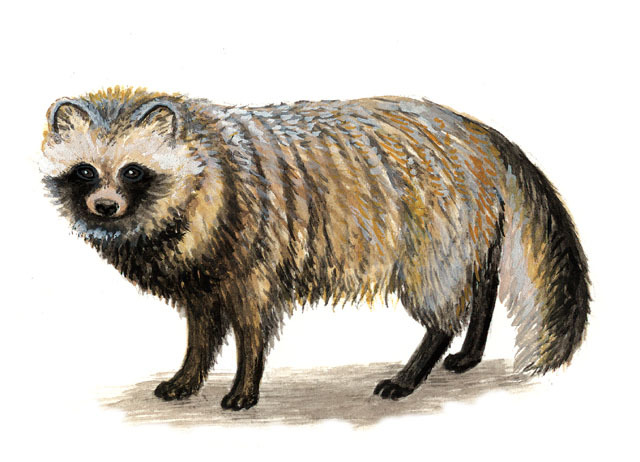
图1. 貉外形示意图(作者Michigan Science Art;来源Animal Diversity Web)
Figure 1. Raccoon dog (Contributor: Michigan Science Art; origin: Animal Diversity Web)
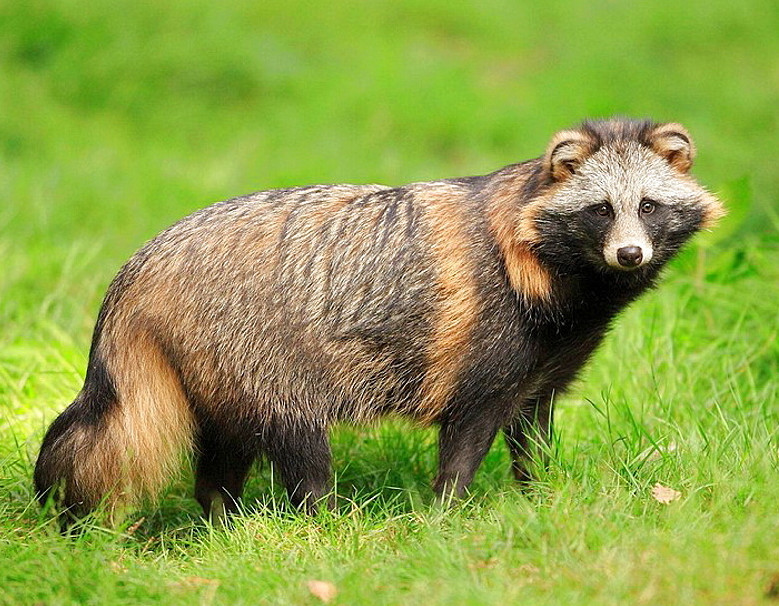
图2. 貉外形实体示意图(来源不明)
Figure 2. Raccoon dog (origin: unknown)
4. 地理分布
貉分布的国家有中国、日本、蒙古、朝鲜、韩国、俄罗斯;欧洲也有貉,但并不是原来就生活在那里的,而是被引入的(图3)。
在中国,貉分布在中部、南部和东部地区(图4);
Raccoon dogs are distributed in China, Japan, Mongolia, North Korea, South Korea and Russia. Raccoon dogs are found in Europe too, but they weren't native there but were introduced (Fig. 3).
In China, raccoon dogs live in central, south and east areas (Fig. 4).
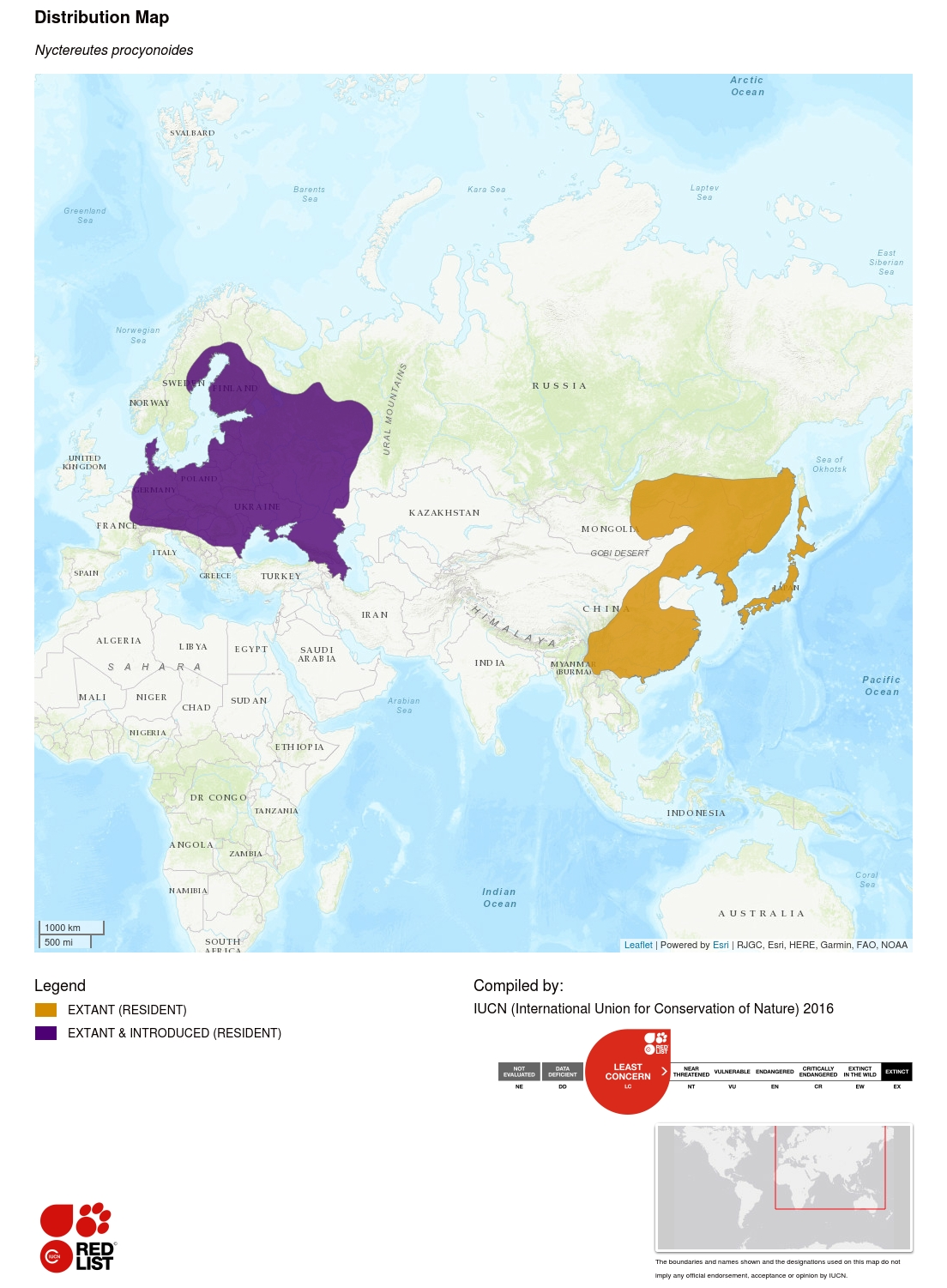
图3. 貉世界范围内地理分布(来源IUCN)
Figure 3. Geographic range of racoon dog around the world (origin: IUCN)
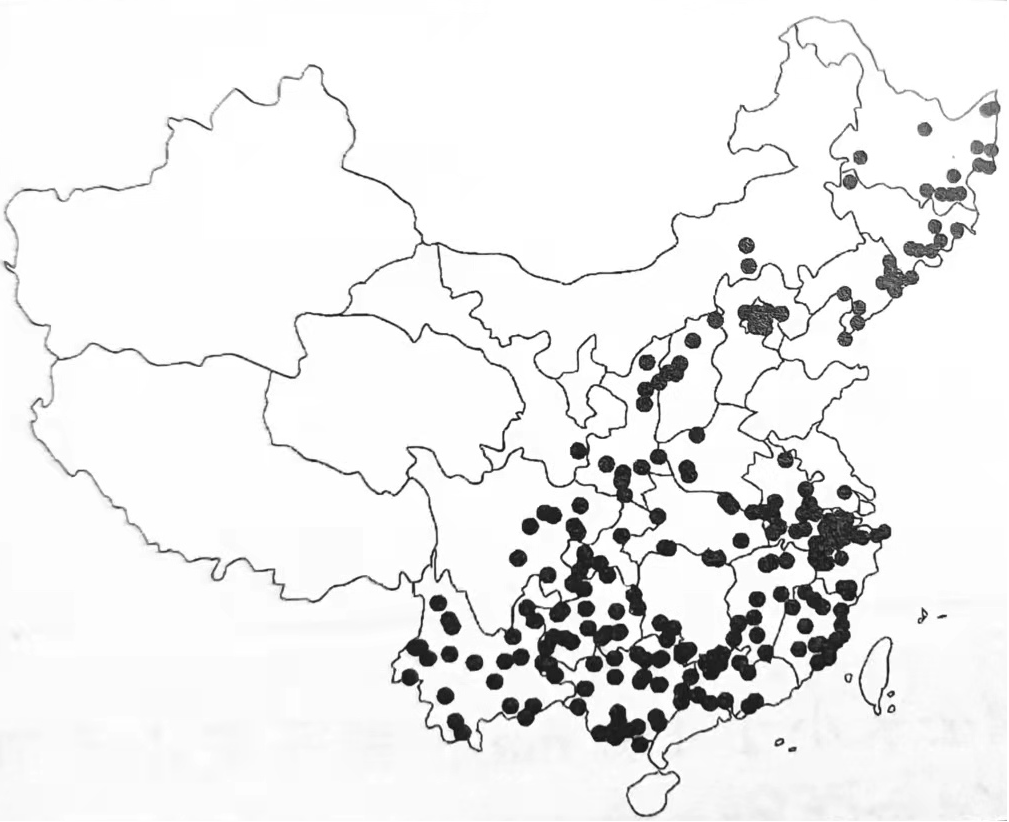
图4. 貉中国范围地理分布(来源《中国兽类野外手册》)
Figure 4. Geographic range of raccoon dog in China (origin: A Guide to the Mammals of China)
5. 栖息环境Habitat
貉栖息于阔叶林中开阔、接近水源的地方,或者开阔的草甸、茂密的灌木丛带和芦苇地;很少出现在高山的茂密森林。貉更喜欢在草木茂盛的林地上,特别是有蕨类植物的林地觅食。
Raccoon dogs inhabit broad leaved forests in open areas close to water, or in open meadows, dense shrubs and reed fields. And they are rarely seen in the dense forests of high mountains. Raccoon dogs prefer to forage in lush woodlands, especially those with ferns.
6. 生活习性Ecology
6.1 食物Food Habits
貉是机会主义杂食者,就是说它一般见着什么就吃什么,食物包括蛙类、软体动物(蜗牛等)、昆虫、鱼类、小型哺乳动物、鸟类和卵、果实和谷物,其中啮齿类(老鼠)所占比例很大,但比其它多数犬科动物(狐狸、狼等)更依赖植物,且吃根、茎、叶、芽、浆果、种子和坚果。
Raccoon dogs are opportunistic omnivores, which means they generally eat what they can find. Their food includes frogs, mollusks (snail, etc.), insects, fish, small mammals, birds and eggs, fruits and grains. Among all food types, rodents (mouse) take a large proportion. They rely more on plant than most other canines (fox, wolf, etc.), and eat roots, stems, leaves, buds, berries, seeds and nuts.
6.2 社群Sociality
独居,一般一只个体单独生活,但有时以家庭群生活或成对觅食。
貉会利用固定的排泄场所“公厕”通过尿液和粪便进行气味的交流。
貉虽然是犬科的,但它们不像其它犬科动物一样“汪汪”地吠叫,它们会呜呜、咪咪地叫,这些象征着友好;当它们咆哮时,则表示攻击性。
Raccoon dogs are usually solitary, but sometimes live and hunt in pairs or small family groups.
Raccoon dogs use latrines to communicate with other members of the species. A latrine is a definite site where an entire group of raccoon dogs will both urinate and defecate.
Raccoon dogs are vocal canids. However, they do not, like all other representatives of the order, bark. They may whine, whimper, or mew; these are all responses coupled with friendly or submissive behavior. They may growl when frightened or when being aggressive.
6.3 家域Home Range
家域范围5-10平方千米。
Home range is 5 to 10 km2.
6.4 节律Rhythm
夜行性,喜欢在晚上活动。
它们是唯一在北方冬眠的犬科动物。
Raccoon dogs are nocturnal animals who are active at night.
They are the only hibernant canid species in north areas.
7. 繁殖Reproduction
貉是一夫一妻制,会组建永久的繁殖对,也就是一只雌性会和一只雄性形成稳固的配偶关系。
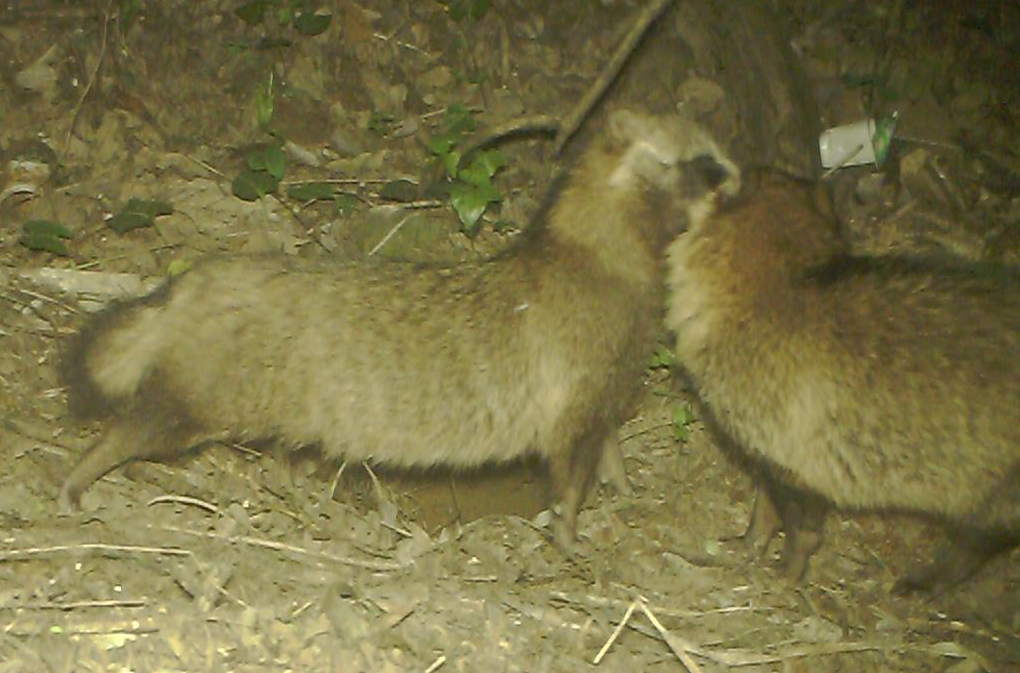
图5. 成对的貉(来源红山动物园小红山生物多样性项目)
Figure 5. Raccoon dog pair (origin: Biodiversity project in Xiao Hongshan of Hongshan Zoo)
在繁殖季节,几只雄性会讨好一只雌性,它们之间稍微有点争斗。当雄性的尾巴呈倒U型时,则意味着它正在发情或捍卫领域。
2-3月交配,孕期59-64天。貉会在浓密的灌木丛下或者洞穴中产仔。每胎5-8仔,但有时多达12仔。
幼仔出生时眼没睁开,身上长有柔软的黑毛。在第9-10天时,幼仔眼睛会睁开。第14-16天,开始长牙。哺乳期持续30-40天。4月龄时,幼仔会跟父母学习觅食。9-11月龄时性成熟。
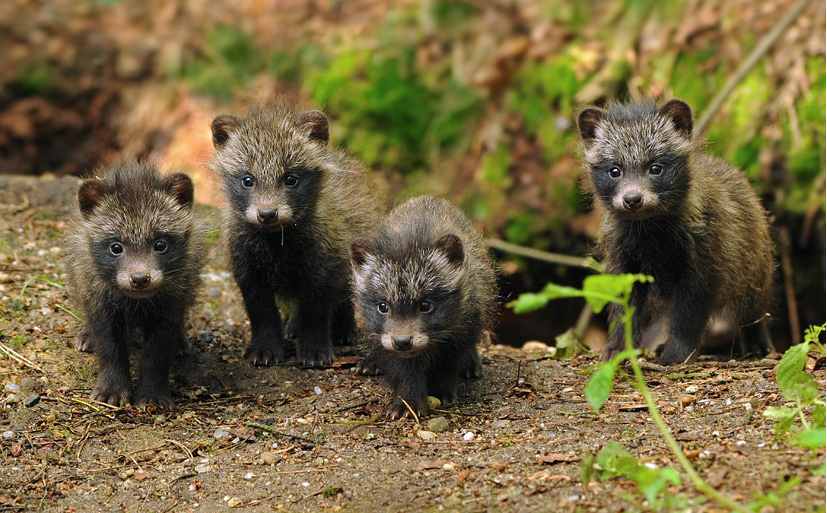
图6. 貉幼仔(来源www. iltaw. com)
Figure 6. Pups of raccoon dog (origin: www. iltaw. com)
一对貉夫妻会一起育幼。雌性出去觅食时,雄性会负责看守幼仔。
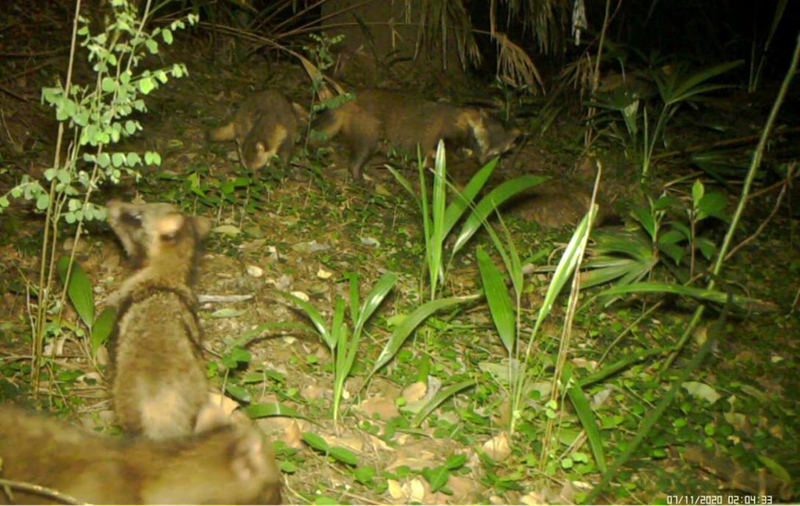
图7. 一个貉家庭:一对夫妻带着三个孩子(来源红山动物园小红山生物多样性项目)
Raccoon dogs are monogamous and form permanent breeding pairs, in which a female forms a stable bond with a male.
During mating, females are courted by 3 to 4 males. There is little fighting among males for mates. An inverted U-shaped tail posture in males is associated sexual arousal and expresses dominance.
Mating happens in February to March, gestation last 59 to 64 days. Raccoon dogs give birth under dense bushes or in caves. Litter size is 5-8, but sometimes as many as 12.
The baby is born with its eyes closed and covered with soft black fur. Between the 9th and 10th day, pups' eyes open and teeth are visible by 14 to 16 days. Mothers wean their pups between 30 to 40 days of age. At 4 months, the pups begin learning how to hunt by watching their parents. The offspring will reach sexual maturity at 9 to 11 months.
A couple will raise a baby together. While the female goes out for hunting, the male guards the young.
8. 保护现状Conservation Status
貉曾认为分布广泛,但如今很少见,可能有地方性绝灭危险。貉作为皮毛兽被广泛养殖,因此国内外均有养殖个体逃逸成为野生个体的现象。
Raccoon dogs, once thought to be widespread, are now rare and may be at risk of endemic extinction. Raccoon dogs are widely bred as fur animals, so there are captive individuals which escape and become wild individuals at home and abroad.
参考文献Reference
CARR K. "Nyctereutes procyonoides" (On-line), Animal Diversity Web[EB/OL]. 2004. https://animaldiversity.org/accounts/Nyctereutes_procyonoides/
KAUHALA K, SAEKI M. Nyctereutes procyonoides. The IUCN Red List of Threatened Species 2016: e.T14925A85658776[EB/OL]. 2016. https://dx.doi.org/10.2305/IUCN.UK.2016-1.RLTS.T14925A85658776.en
SMITH A T, 解焱. 中国兽类野外手册[M]. 长沙: 湖南教育出版社, 2009.
国家林业和草原局/国家公园管理局. 国家重点保护野生动物名录[EB/OL]. 2021. http://www.forestry.gov.cn/html/main/main3954/20210225160347342521589/file/20210225160401102702964.pdf
刘少英, 吴毅. 中国兽类图鉴[M]. 福州: 海峡书局, 2019.